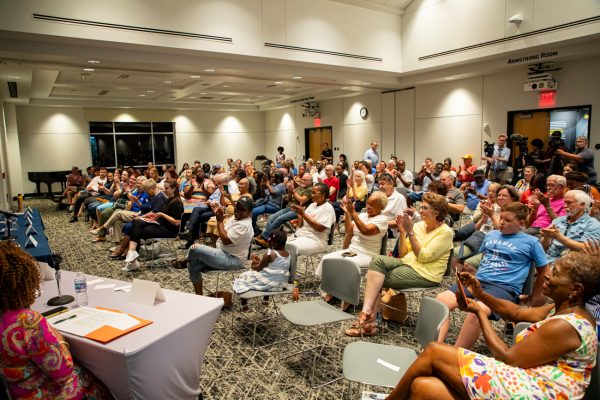Forum exposes community to maker space functions
Members of the Wichita community attended a forum at Thursday about understanding the purpose and functions of maker spaces.
Dominic Canare — president and a founding member of MakeICT, a makerspace in downtown Wichita — offered an explanation.
“If you’ve never heard of a maker space, think of it like a YMCA. But instead of equipment for building your body, we have equipment for building stuff,” Canare said.
Maker spaces are places where people can get a membership to use machinery and resources housed in one location in order to create an invention or product.
The forum, titled “The MakerSpace Revolution,” was hosted by WSU Ventures and moderated by Cindy Claycomb, director of the program. The forum was part of a series of free discussions presented by Meritrust Credit Union and the WSU Center for Entrepreneurship.
The forum included three panelists involved in different maker spaces in Kansas. Paul Adams, the dean of Fort Hays State University’s College of Education and Technology, is an administrator for the maker space at FHSU. Canare, a second year graduate student at WSU, is the president and a founding member of MakeICT, a maker space in downtown Wichita. Nathan Towle is the supervisor of the Educational Services and Staff Development Association of Central Kansas (ESSDACK) maker space, located in the Hutchinson mall.
Claycomb said the main ideas for hosting the forum were to expose people on campus and in the community on what the space is for, and to get them thinking on how they are going to utilize it.
The forum started with a short promotional video for GoCreate, the maker space being built in conjunction with the Experiential Engineering Building on Innovation Campus at WSU. The video was a compilation of animations using the GoCreate logo and a dubstep soundtrack.
The panelists said anyone from students to community members can use their maker spaces and resources such as soldering materials, 3D printers, wood shops, laser cutters and textile and printmaking studios for their projects.
In addition, maker spaces can vary in sizes. Adams said the maker space at FHSU has 800 square feet of space, while Canare said MakeICT has 8,700 square feet. Towle said the ESSDACK Makerspace uses a 60-by-30 foot main room with a couple of smaller rooms for additional equipment.
Since WSU will have GoCreate next fall, Claycomb asked about the process of starting a maker space.
“If someone just wants to build one, I think just starting with [which] community is probably a good place to go,” Towle said. “As long as you have people who are passionate about what they want to do, I think that finding those people and linking them up is probably beneficial.”
Adams and Canare also mentioned that the community and networking are important aspects of starting a maker space.
When asked about monetary aspects, Adams said FHSU’s maker space is funded in part through donations
“The other way that we fund it is creative use of other projects … We’ve had grant projects that were funded that dealt with those sorts of things. We’re able to use some of the equipment that may have been bought,” he said.
This means that, in addition to donations, leftover grant money may be used to buy equipment. Adams also said the FHSU library paid for students to staff the maker space beause it’s located in the basement of the library.
Towle said the ESSDACK Makerspace is entirely funded by ESSDACK with the option for visitors to give donations, but he is considering other funding sources such as business grants and a membership model for the public. MakeICT is funded by the membership fees, and there are about 150 members at that maker space. Canare also said MakeICT is entirely staffed by volunteers, like himself.
Although there are many components of starting and operating a maker space, the panelists shared how they respond to struggles and goals and how they garnered success with their maker spaces.
WSU senior Chris French attended the forum as part of his entrepreneurship class and was interested in the topic of discussion.
“I worked with a maker space before at MakeICT. I wanted to see what they were going to say or if they had any announcements to make,” French said.
French used MakeICT to create an “emulation station” as a gift for his girlfriend — a computer that fits inside the frame of a Nintendo 64 video game console. It allows people to play video game emulators through the computer while still keeping the classic video game feel by including the N64 body.
Claycomb said she was pleased with how the forum went.
“I’m glad that people are interested,” she said. “I saw students, faculty, staff and friends from the community. And that was nice.”







